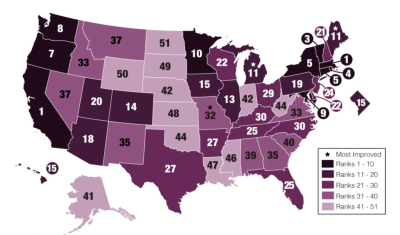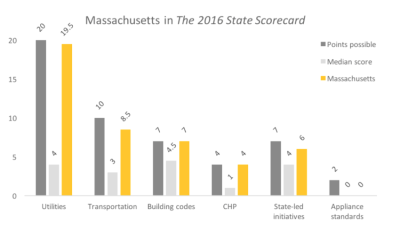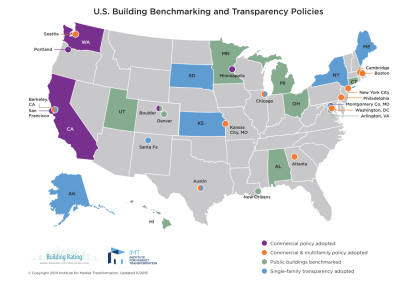Welcome to October....It's Energy Awareness Month!
To celebrate in style, I thought it would be worth highlighting that the American Council for An Energy Efficient Economy (ACEEE) has put out their 10th edition of the State Energy Efficiency Scorecard. For the 6th year in a row, my home state of Massachusetts is #1! Which is always something I am happy to share, though this year we are sharing the top billing with California.

The objective of the Scorecard is to rank states on their energy efficiency efforts and ultimately encourage them to keep pushing towards being #1. We have seen that improved efficiency promotes economic growth and improves environmental quality. The report examines policies, programs, best practices, and overall leadership in six policy areas:
- Utility and public benefits programs and policies
- Transportation policies
- Building energy codes and compliance
- Combined heat and power (CHP) policies
- State government–led initiatives around energy efficiency
- Appliance and equipment standards
Additionally, this year ACEEE gave credit to those states that have PACE enabling legislation “to recognize innovative state efforts to leverage private capital toward efficiency goals.” PACE stands for Property Assessed Clean Energy and it is a financing mechanism that is growing in popularity as it allows energy efficiency, clean energy, and resilience improvements to a property to be financed through property taxes. A lien is placed on the property until paid in full, but this addresses concerns that short-term owners have had with efficiency and other improvements that might have a longer payback period than the amount of time they are interested in staying in the building. You can find out more on the PACENation website.
So how does Massachusetts do it?
 To be #1 for six years in a row is something. What does Massachusetts have or do that is so special? Well, according to ACEEE, “Massachusetts has one of the most ambitious energy efficiency resource standards in the country”- that means we have established specific, long term targets for reducing energy use that the utilities in the state must meet. The Commonwealth also passed the Green Communities Act back in 2008, which identified energy efficiency as a first priority resource throughout the state and set up a number of programs to support that, including the Green Communities program which drives energy efficiency at the local level as well. For more information: http://www.mass.gov/eea/energy-utilities-clean-tech/green-communities/ .
To be #1 for six years in a row is something. What does Massachusetts have or do that is so special? Well, according to ACEEE, “Massachusetts has one of the most ambitious energy efficiency resource standards in the country”- that means we have established specific, long term targets for reducing energy use that the utilities in the state must meet. The Commonwealth also passed the Green Communities Act back in 2008, which identified energy efficiency as a first priority resource throughout the state and set up a number of programs to support that, including the Green Communities program which drives energy efficiency at the local level as well. For more information: http://www.mass.gov/eea/energy-utilities-clean-tech/green-communities/ .
While these are great achievements, Massachusetts needs to keep driving forward to maintain its claim in the top spot. California will keep us on our toes. There were three categories that California scored higher than Massachusetts: Transportation, State Government Initiatives, and Appliance Efficiency Standards.

On the Transportation side, Massachusetts needs to actually achieve significant reductions in vehicle miles travelled per capita. We have not been able to demonstrate that yet. Under State Government Initiatives, the missing point is for a statewide building benchmarking and transparency requirement. This is a fairly innovative policy at the state level. Local governments have been leading in this area for several years now. It will be interesting to see if/how various states step up to take this on. Clearly California already has, but so have a few others to varying extents- Washington, D.C., Alaska, New York, and Kansas to name a few. The Institute for Market Transformation has created a great map (below) highlighting the state and local benchmarking policies across the country.
Finally, under appliance standards, well California set the bar here and while Massachusetts had previously had appliance standards, we are now just working with the federal standards.
How can your state improve its ranking on the scorecard?
Like Massachusetts, California and other states in the top ten are there because they have moved well past the voluntary programs and into strong legislative action that establishes standards for efficiency that must be met and those standards are tightened on a regular basis. I have worked with lots of local governments in many other states and that is the differentiating factor in successfully moving towards a more sustainable community. We have to stop being scared to REQUIRE these changes. Massachusetts, California, and others are proving that you can enforce strict efficiency standards and actually spur growth- not stifle it. This is a great lesson for those that feel beholden to developers and others that are constantly fighting these necessary changes.So while you are prepping for Halloween, remember that While jack-o-lanterns can be fun for Halloween, they are not really practical and therefore not your best strategy to become more energy efficient.
Whether considering state level legislation action or not, ACEEE suggests these strategies improve your statewide energy efficiency efforts:
- Establish and adequately fund an EERS or similar energy savings target.
- Adopt updated, more stringent building energy codes, improve code compliance, and involve efficiency program administrators in code support.
- Set quantitative targets for reducing VMT, and integrate land use and transportation planning.
- Treat cost-effective and efficient CHP as an energy efficiency resource equivalent to other forms of energy efficiency.
- Expand state-led efforts—and make them visible.
- Explore and promote innovative financing mechanisms to leverage private capital and lower upfront costs of energy efficiency measures.
GOOD LUCK!


